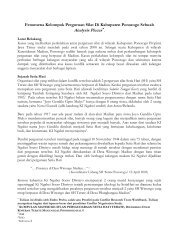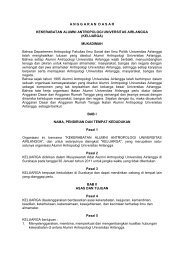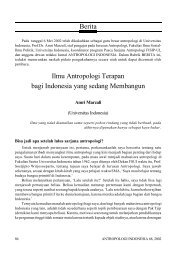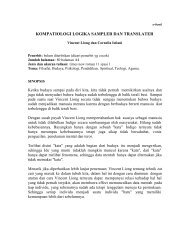The Future of Visual Anthropology: Engaging the Senses
The Future of Visual Anthropology: Engaging the Senses
The Future of Visual Anthropology: Engaging the Senses
Create successful ePaper yourself
Turn your PDF publications into a flip-book with our unique Google optimized e-Paper software.
widijanto judono e-Library collection - widijanto.wordpress.com<br />
Interdisciplinary agendas 25<br />
<strong>The</strong> Nanook <strong>of</strong> <strong>the</strong> North debate is exemplary <strong>of</strong> how contemporary attempts to<br />
define <strong>the</strong> history <strong>of</strong> visual anthropology focus on questions <strong>of</strong> reflexivity,<br />
constructedness, realism and ethics. While Rony appropriates a popular postcolonial<br />
critique <strong>of</strong> objectifying truth claims, Ruby argues that Flaherty’s was a selfaware<br />
project where he collaborated with his film’s subjects to produce a film that<br />
represented <strong>the</strong>ir everyday lives to a wide audience by portraying how dramatic<br />
events were played out. Ruby thus situates Flaherty’s as an ethical project that<br />
accounted for <strong>the</strong> views <strong>of</strong> his subjects, and was overtly constructed. Nanook played<br />
on ideas <strong>of</strong> realism but because it intended to represent everyday life it did not claim<br />
to be an objective recording <strong>of</strong> reality lived in real time, and it was probably not<br />
taken to be so by audiences.<br />
Mead and Bateson in Bali and Evans-Pritchard’s Nuer: uniquely<br />
innovative or exoticising and <strong>of</strong>fensive?<br />
Margaret Mead’s work with photography and film and her efforts to promote <strong>the</strong><br />
visual in social science research have had a lasting impact on <strong>the</strong> development <strong>of</strong><br />
visual anthropology and visual sociology. Writers in both disciplines <strong>of</strong>ten cite her<br />
written and visual work and her call for <strong>the</strong> use <strong>of</strong> images in what she famously<br />
referred to as a ‘discipline <strong>of</strong> words’ (1975). 3 Mead argued that <strong>the</strong> visual could be<br />
harnessed to support <strong>the</strong> objectives that existed for <strong>the</strong> social science research <strong>of</strong><br />
her time: namely <strong>the</strong> realist recording <strong>of</strong> ‘objective’ data that could be analysed to<br />
<strong>the</strong> ends <strong>of</strong> anthropological inquiry. This exemplifies what we might call <strong>the</strong> ‘observational’<br />
approach, as Banks puts it: <strong>the</strong> assumption ‘that simply to watch someone<br />
is to learn something about <strong>the</strong>m’ and in doing so to generate ‘knowledge that can<br />
be later analysed and converted into intellectual capital’ (Banks 2001: 112). Banks<br />
is referring to Mead’s chapter in Hockings’ 1975 Principles <strong>of</strong> <strong>Visual</strong> <strong>Anthropology</strong><br />
(1995). <strong>The</strong> observational approach was an important characteristic <strong>of</strong> social<br />
research methods in Mead’s era, and she sought to employ <strong>the</strong> visual to serve this<br />
agenda. Situated in <strong>the</strong> historical development <strong>of</strong> ‘ways <strong>of</strong> seeing’ in anthropology,<br />
this was a period in which ‘much energy was expended in seeking to legitimate<br />
ethnographic film as an acceptable scientific endeavour’ (Grimshaw 2001: 88).<br />
Over 25 years later it ‘seems hopelessly outdated’ (Banks 2001: 112), because most<br />
anthropologists would regard <strong>the</strong> processes by which knowledge is produced during<br />
research as <strong>the</strong> outcome <strong>of</strong> <strong>the</strong> relationship and negotiations between <strong>the</strong> researcher<br />
and informants, ra<strong>the</strong>r than <strong>of</strong> <strong>the</strong> former’s objective observation <strong>of</strong> <strong>the</strong> latter.<br />
<strong>Visual</strong> anthropology has certainly moved on. Yet some recent misreadings <strong>of</strong> <strong>the</strong><br />
history <strong>of</strong> ideas in visual anthropology have characterised Mead’s 1975 proposals as<br />
if <strong>the</strong>y were dominant ideas in contemporary visual anthropology. For example,<br />
Holliday (2001) represents Mead’s argument (reprinted in 1995) as an objective<br />
approach characteristic <strong>of</strong> visual anthropology at <strong>the</strong> end <strong>of</strong> <strong>the</strong> twentieth century.<br />
Any critique <strong>of</strong> Mead’s work needs to situate her work historically; as she died in<br />
1978 her ideas do not represent those <strong>of</strong> a visual anthropology <strong>of</strong> <strong>the</strong> 1990s (see<br />
Pink 2001b).










